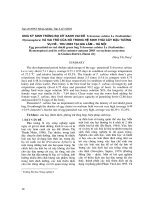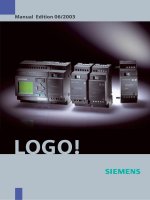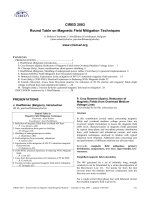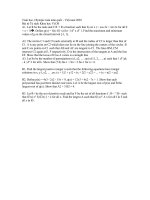D962 81(reapproved 2003)
Bạn đang xem bản rút gọn của tài liệu. Xem và tải ngay bản đầy đủ của tài liệu tại đây (20.59 KB, 2 trang )
Designation: D 962 – 81 (Reapproved 2003)
Standard Specification for
Aluminum Powder and Paste Pigments for Paints1
This standard is issued under the fixed designation D 962; the number immediately following the designation indicates the year of
original adoption or, in the case of revision, the year of last revision. A number in parentheses indicates the year of last reapproval. A
superscript epsilon (e) indicates an editorial change since the last revision or reapproval.
3.4.1 Class A, Fine—Maximum of 0.1 % retained on a No.
325 (45-µm) sieve.
3.4.2 Class B, Medium—Maximum of 1.0 % retained on a
No. 325 (45-µm) sieve.
3.4.3 Class C, Coarse—Maximum of 11.0 % retained on a
No. 325 (45-µm) sieve.
1. Scope
1.1 This specification covers four types and three classes of
aluminum pigments for use in paints.
2. Referenced Documents
2.1 ASTM Standards:
D 480 Test Methods for Sampling and Testing of Flaked
Aluminum Powders and Pastes2
E 34 Test Methods for Chemical Analysis of Aluminum and
Aluminum-Base Alloys3
NOTE 1—The particle size characteristics of the Type 3 and Type 4
pigments of the same class do not correspond with each other; in the case
of Types 1 and 2 they do.
4. Composition and Properties
4.1 Aluminum Pigment Powder (Type 1, Leafing and Type
3, Nonleafing)—The aluminum pigment powder shall consist
of commercially pure aluminum in the form of fine, polished
flakes, and a suitable fatty lubricant. It shall contain no filler or
extender pigments.
4.2 Aluminum Pigment Paste (Type 2, Leafing and Type 4,
Nonleafing)—The aluminum pigment paste shall consist of
commercially pure aluminum in the form of fine, polished
flakes, and a suitable fatty lubricant combined with a volatile
thinner. It shall contain no filler or extender pigments.
4.3 The aluminum pigments, powder, and paste of both
leafing and nonleafing types shall conform to the requirements
given in Table 1.
4.4 The paint made from the powder or paste shall be
free-flowing and shall give a continuous coating at least equal
in smoothness, luster, and general appearance to that of a
reference sample mutually agreed upon by the purchaser and
the seller.
4.5 The aluminum pigments, powder and paste of both
leafing and nonleafing types, stored in unopened original
packages within 6 months after shipment shall pass all tests
applicable to the respective type and class as described in Test
Methods D 480.
3. Classification
3.1 Type I—Leafing Aluminum Pigment Powder:
3.1.1 Class A, Fine—Maximum of 0.1 % retained on a No.
325 (45-µm) sieve.
3.1.2 Class B, Medium—Maximum of 1.5 % retained on a
No. 325 (45-µm) sieve.
3.1.3 Class C, Coarse—Maximum of 20 % retained on a
No. 325 (45-µm) sieve.
3.2 Type II—Leafing Aluminum Pigment Paste:
3.2.1 Class A, Fine—Maximum of 0.1 % retained on a No.
325 (45-µm) sieve.
3.2.2 Class B, Medium—Maximum of 1.0 % retained on a
No. 325 (45-µm) sieve.
3.2.3 Class C, Coarse—Maximum of 15 % retained on a
No. 325 (45-µm) sieve.
3.3 Type III—Nonleafing Aluminum Pigment Powder
(Note):
3.3.1 Class A, Fine—Maximum of 1.5 % retained on a No.
325 (45-µm) sieve.
3.3.2 Class B, Medium—Maximum of 6.0 % retained on a
No. 325 (45-µm) sieve.
3.3.3 Class C, Coarse—Maximum of 20 % retained on a
No. 325 (45-µm) sieve.
3.4 Type IV—Nonleafing Aluminum Pigment Paste (Note 1):
5. Test Methods and Sampling
5.1 Sampling and tests shall be conducted in accordance
with Test Methods D 480. Since several of the methods are
empirical and the results are affected by the method, the
specified procedures should be closely followed.
1
This specification is under the jurisdiction of ASTM Committee D01 on Paint
and Related Coatings, Materials, and Applications and is the direct responsibility of
Subcommittee D01.31 on Pigment Specifications.
Current edition approved Oct. 1, 2003. Published October 2003. Originally
approved in 1948. Last previous edition approved in 1981 as D 962 – 81 (1999).
2
Annual Book of ASTM Standards, Vol 06.03.
3
Annual Book of ASTM Standards, Vol 03.05.
Copyright © ASTM International, 100 Barr Harbor Drive, PO Box C700, West Conshohocken, PA 19428-2959, United States.
1
D 962 – 81 (2003)
TABLE 1 Requirements for Aluminum Pigments
Leafing
Nonvolatile matter at 105 to 110°C, min, %
Easily extracted fatty and oily matter (polishing lubricant), max,%A
Total impurities other than fatty and oily matter, max, %A
Coarse particles, max, %:
Class A (total residue retained on a No. 325 (45-µm) sieve)
Class B (total residue retained on a No. 325 (45-µm) sieve)
Class C (total residue retained on:
No. 100 (150-µm) sieve
No. 325 (45-µm) sieve)
Leafing, min, %:
Class A
Class B
Class C
A
Nonleafing
Type 1
(Powder)
Type 2
(Paste)
Type 3
(Powder)
Type 4
(Paste)
99
4.0
1.0
65
3.0
0.7
99
4.0
1.0
65
3.0
1.25
0.1
1.5
0.1
1.0
1.5
6.0
0.1
1.0
0.5
20.0
0.5
15.0
0.5
20.0
0.5
11.0
50
50
50
55
50
50
absent
absent
absent
absent
absent
absent
Nonleafing pigments may contain metal compounds as dispersants. If required, a complete analysis may be made in accordance with Test Methods E 34.
6. Packaging
6.1 Aluminum paste should be packaged in a polyvent
container that can be safely vented in case of pressure build-up.
7. Keywords
7.1 aluminum powder; flake; leafing; nonleafing; paste;
polishing lubricant
ASTM International takes no position respecting the validity of any patent rights asserted in connection with any item mentioned
in this standard. Users of this standard are expressly advised that determination of the validity of any such patent rights, and the risk
of infringement of such rights, are entirely their own responsibility.
This standard is subject to revision at any time by the responsible technical committee and must be reviewed every five years and
if not revised, either reapproved or withdrawn. Your comments are invited either for revision of this standard or for additional standards
and should be addressed to ASTM International Headquarters. Your comments will receive careful consideration at a meeting of the
responsible technical committee, which you may attend. If you feel that your comments have not received a fair hearing you should
make your views known to the ASTM Committee on Standards, at the address shown below.
This standard is copyrighted by ASTM International, 100 Barr Harbor Drive, PO Box C700, West Conshohocken, PA 19428-2959,
United States. Individual reprints (single or multiple copies) of this standard may be obtained by contacting ASTM at the above
address or at 610-832-9585 (phone), 610-832-9555 (fax), or (e-mail); or through the ASTM website
(www.astm.org).
2









